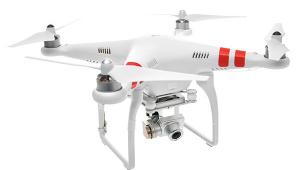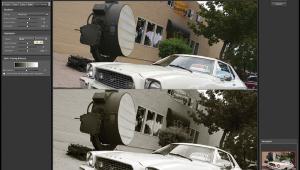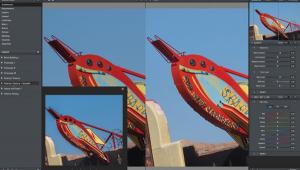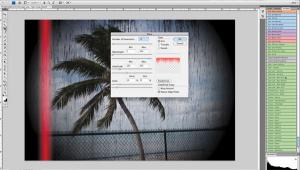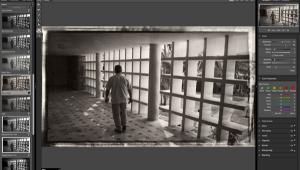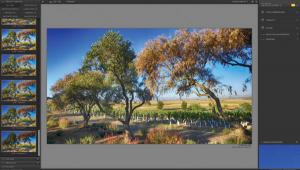Digital Innovations
Seeing Is Photography, No Matter How You Capture Images
| It makes no difference if you take pictures with a Pentax K-1000 and paste them into an album or capture images using an Epson 850Z digital camera and place them in an eBooks digital album or on the web at PhotoPoint.com, photography has always been about vision. While this column is about creating images using new digital tools, I don't live in a vacuum. Many of the images you see here were originally captured on film since I remain an active user of traditional SLR and rangefinder cameras using film from Agfa, Fuji, Kodak, and Ilford. Yet, more and more of my images are being captured in digital form on media from Delkin, Lexmark, and Microtech. I remain as much in love with film as when I was 8 years old and made my first photograph of an American flag flying from a pole in Collington Square in Baltimore. Digital imaging offers several advantages that can help you become a better photographer--faster. · Digital photography
is truly instant. Within microseconds of capturing an image, you can
view it on the camera's LCD preview screen. If the camera you're
considering doesn't have one--and there are few that don't
offer this feature anymore--keep looking. Being able to see the image
you just made will show how that telephone pole that was near your significant
other all of a sudden jumped into the background and now appears to
be growing out of his or her head. Thankfully, reshoots, like the original
capture, are instantaneous, too. · In camera editing also saves money by maximizing the space on your CompactFlash, SmartMedia, or Mem-ory Stick storage media, which are still more costly than a roll of film. The big advantage, of course is that all of these types of digital film are reusable, something not possible with film. · Improving your photography includes time spent in the digital darkroom, too. Readers are always asking me about the best book available on Photoshop and other image-editing programs. I try to answer that question in my annual roundup of digital imaging books in the December issue, but the best way to learn anything about Photoshop is to emulate Nike's slogan and Just Do It! Spend an hour a day--I do--or even an hour a week playing with your favorite image-editing program. The important word here is play. Play with your images, massage a few menus, slide some sliders, and watch what happens. Investigate some of the automatic controls such as Adjust>Auto Levels and Adjust>Auto Contrast (they're in the Image menu). Photoshop snobs will tell you to avoid any of these automatic controls but in desperation while working with a tricky black and white image, I selected Auto Contrast and the image finally looked the way I wanted. As Agent Mulder says, "Trust no one," and make up your own mind while playing with your images. · Surf the web looking for demos and freeware plug-ins to enhance your play. There's tons of stuff out there; some of it is very good, but I promise if you take the time to explore, you will learn something and maybe even improve your images. Recently, I discovered www. fantasticmachines.com who offers a package of 21 plug-ins for $39.95, and you can download a demo for free to see if you like it. Use Yahoo or your favorite portal site then type in "plug-ins" and see what kind of hits you get. New Gray Scale Plug-In. Silver Oxide.com, Inc. is offering a new Photoshop compatible plug-in to render a color image as if it were shot with a specific type of black and white film, such as Kodak's Tri-X or T-Max. The Windows-only beta version I tested emulates Kodak Tri-X, T400CN, and T-Max films. The company tells me that a Sepia/Warm Toning filter set that applies warming effects to the image after it's been converted into gray scale will be offered as an incentive when the package ships. SilverOxide feels that Photoshop's built-in gray scale conversion uses color sensitivities that appear unrelated to real world black and white film; it simply removes all of the color. The concept behind their plug-ins is that each brand and type of black and white film offers differing sensitivities to primary colors. Kodak's Tri-X, for example, has a different way of interpreting the color palette than Kodak T-Max or Agfapan. SilverOxide.com mapped these different responses and built them into the plug-in so a digital photographer can render a color image as black and white as if it were actually made with your favorite film. While aimed at professional portrait photographers as a way to increase the amount and kind of images they can show their customers, the Black Modeling filter kit will be of interest to any pixographer. The list price on the kit will be $129.00 with an introductory price of $69.95, including the Sepia/Warm Toning filters. By the time you read this, the shipping product should be available. For more information, visit SilverOxide's web site at: www.silveroxide.com. While there, take some time to look at the comparison images showing how their filters convert color images to gray scale compared to results using Photoshop's gray scale command. Bet'cha Can't Use Only One. I really enjoy applying creative edges to digital images. It's one of the more fun digital darkroom techniques for me and, gathering from reader reaction, for many of you, too. Since you can't have too many edge effects, Auto F/X's newest collection, called Photo/Graphic Edges 10,000+, includes Mac OS and Windows versions of the company's edge making plug-in plus more than 10,000 edge and texture effects. The plug-in lets you control edge effects for producing feathered deckles, custom edges, or creative backgrounds. You can control an edge's size, orientation, position, rotation, along with its softness, border width, color, and shape. Some of the plug-in's controls let you apply special effects that make the edges look like burnt paper or add a sepia or mezzotint look to an image. You can bevel or carve the edges to give your photographs a three-dimensional depth. The plug-in includes lighting tiles to add a custom look and feel. Photo/Graphic Edges also lets you load multiple edges for an infinite combination of looks. The plug-in's preview window, while a little smaller than I might prefer, provides a real-time look at the effects as you work with them. The 10,000+ package includes an instruction manual and a 300 page printed catalog showing all the edge effects and textures on four CDs. You'll also find a version that can be installed as a stand-alone application. List price for Photo/Graphic Edges 10,000+ is $199 and can be ordered from the company's web site at: www.autofx.com. Plug-In News. At the PMA show recently there was a flood of rumors about MetaCreations. Mostly they centered around a story that the company was selling its graphic packages such as Painter, KPT, and others. After the show, I spoke with a company representative who told me that MetaCreations is focusing solely on e-commerce solutions for the World Wide Web using the company's patented MetaStream technology. As part of this new strategy, they are selling all of their graphics software, including Painter, KPT, and others. MetaCreations is in negotiations with companies to purchase these products and I'll let you know what happens to this wonderful software. Photo Printing On A Budget. No sooner had I finished my PMA Show report on new digital products, when Hewlett-Packard announced a new photo quality printer for pixographers on a budget. The DeskJet 840C/842C printer continues the company's practice of assigning two different model numbers to an identical printer when the only difference is the software that's bundled with it. The printer uses a new tricolor ink jet cartridge designed for price sensitive users, such as those who have a digital camera and can go through an ink cartridge within a few hours of play. The printer offers an alternative photo mode, which prints up to 1200 dots per inch on photo paper such as HP's own Premium Photo Paper. Output can roll off the printer at speeds up to eight pages per minute for text and five pages per minute when printing color output. The printer has both parallel and USB ports making it compatible with Windows and Macintosh environments. For more information, visit www.deskjet.com. Other Post PMA News. At the Photo Marketing Associations show in February, the German company Tetenal won the competition for ink jet papers. The winning paper was Tetenal Spectra Jet Duo Paper Matte/matte, which convinced the judges by its photo-realistic reproduction on both sides, excellent whites, high ink absorption, brilliance, and durability. The Duo paper has a weight of 80 lbs or 130 gms per square meter and is supplied in packages of 100 sheets in letter and 11x17" sizes. Tetenal is distributed in the US by HP Marketing. For more information contact HP, or visit Tetenal's web site at: www.tetenal.com. New Ink Jet Photo Papers.
Recently, I've been testing the Epson Stylus Photo 1270 ink jet
printer using several brand new papers available from Adorama. These
are textured papers that are part of the company's ProJet line
which include Standard, Delicate, and Coarse Fine Art paper as well
as two others called Weave and Goatskin Parchment. Many of them remind
me of the heavyweight papers I've been purchasing at art supply
stores, but these are designed specifically for ink jet printing. They
are available in letter, 11x17, and 17x22" sizes in packs of 10
or 50. A larger mini-poster-sized 13x19" paper should be available
by the time you read this. Prices are expected to range from $22.95
for 10 sheets of the Goatskin and Weave to $25 for the Fine Art papers.
At this time, pricing is preliminary and may be lower when you place
an order. My initial testing with a few early samples using the Epson
1270 printer showed that they were a lot of fun to work with. When printing
black and white or color portraits, the Coarse and Delicate Fine Art
papers produced an artistic quality not unlike some of Kodak's
old textured printing papers. For more information about Adorama's
ink jet papers, call (800) 223-2500 or visit their web site at: www.adoramacamera.com. The new Portfolio line offers three product configurations: · Portfolio 5.0 operates as a stand-alone, customizable imagebase program for individuals and small work groups, allowing you to organize and manage digital content. PortWeb, Extensis' new web server plug-in, is included free with this version and lets you create an intranet, extranet, or Internet site for sharing images. Users can search for photographs using their web browser while PortWeb handles the request between the web server and Portfolio database before submitting the results back to the user. These users could be employees of a photography studio, external resellers or licensees. · Portfolio Server 5.0 lets work groups share collections of digital images via local area networks or the Internet. This package consists of five Portfolio5.0 clients, PortWeb, and Portfolio Server. More clients can be purchased as needed. · Portfolio SQL offers high volume access to digital media for large organizations through an intranet or the Internet connection and is designed for corporate users who need to connect Portfolio Server 5.0 with a Microsoft SQL (Structured Query Language) Server or Oracle database. The retail price of Portfolio 5.0 for single users is $199.95. The program supports Power Macintosh models running OS 8.1 to 9 as well as users of Microsoft Windows 95, 98, 2000, and NT 4. Multiple user versions will be priced higher. For more information, check the company's web site at: www.extensis.com. Windows On A Mac. While I must confess that I've always believed that if you were a Mac person who needed to run a few Windows applications, the best solution was buying an inexpensive PC. I still think that's true but I also recognize that some people only need to run the occasional Windows program and would prefer to work with a single computer. Emulation software has been around for a long time and last year after FWB Software acquired the SoftWindows and RealPC product lines from Insignia Solutions, they improved the software and released a new version. SoftWindows 98 Version 5.1 and RealPC Version 1.1 let you run Windows or even DOS applications on your Macintosh computer without any additional hardware. For $159.95, SoftWindows 98 Version 5.1 lets you launch PC files and run Windows applications through a web browser interface on a Power Macintosh--including G3, G4, PowerBook, iBook, and iMac. The package includes a copy of Microsoft Windows 98 Second Edition pre-installed and is ready to run. RealPC Version 1.1 mimics an Intel Pentium-powered PC and lets you run DOS applications and games on a Power Macintosh for $29.95. More information can be found at: www.fwb.com. |
